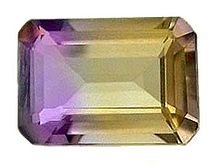Ametrine
Mineral, quartz variety From Wikipedia, the free encyclopedia
Mineral, quartz variety From Wikipedia, the free encyclopedia
Ametrine, also known as trystine or by its trade name as bolivianite, is a naturally occurring variety of quartz. It is a mixture of amethyst and citrine with zones of purple and yellow or orange. Almost all commercially available ametrine is mined in Bolivia.
| Ametrine | |
|---|---|
 | |
| General | |
| Category | Silicate mineral |
| Formula (repeating unit) | Silica (silicon dioxide, SiO2) |
| Crystal system | Hexagonal |
| Identification | |
| Formula mass | 60.08 g/mol |
| Color | Purple, Yellow |
| Crystal habit | 6-sided prism ending in 6-sided pyramid (typical) |
| Twinning | Dauphine law and Brazil law |
| Cleavage | none |
| Fracture | Conchoidal |
| Mohs scale hardness | 7 |
| Lustre | Vitreous |
| Streak | white |
| Diaphaneity | Transparent to translucent |
| Specific gravity | 2.65 |
| Optical properties | Unixal (+) |
| Refractive index | nω = 1.543–1.553 nε = 1.552–1.554 |
| Birefringence | +0.009 |
| Pleochroism | Amethyst section shows weak to moderate purple/reddish purple Citrine section shows very weak yellow/orange [1] |
| Melting point | 1650±75 °C |
| Diagnostic features | Distinct segments that are purple and yellow |
| Solubility | Insoluble in common solvents |
| Common impurities | Iron |
The colour of the zones visible within ametrine are due to differing oxidation states of iron within the crystal. The citrine segments have oxidized iron while the amethyst segments are unoxidized. The different oxidation states occur due to there being a temperature gradient across the crystal during its formation. Artificial ametrine is grown with the hydrothermal method using solutions doped with specific elements, followed by irradiation of the created crystals.[2]
Ametrine in the low price segment may stem from synthetic material. Green-yellow or golden-blue ametrine does not exist naturally.

Ametrine is composed of silicon dioxide (SiO2) and it is a tectosilicate, which means it has a silicate framework linked together through shared oxygen atoms.
Legend has it that ametrine was first introduced to Europe by a conquistador's gifts to the Spanish Queen in the 1600s, after he received a mine in Bolivia as a dowry when he married a princess from the native Ayoreos tribe.[3]
Seamless Wikipedia browsing. On steroids.
Every time you click a link to Wikipedia, Wiktionary or Wikiquote in your browser's search results, it will show the modern Wikiwand interface.
Wikiwand extension is a five stars, simple, with minimum permission required to keep your browsing private, safe and transparent.